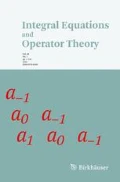Abstract
The theory of 2×2 trace-normed canonical systems of differential equations on ℝ+ can be put in the framework of abstract extension theory, cf. [9]. This includes the theory of strings as developed by I.S. Kac and M.G. Kreįn. In the present paper the spectral properties of such canonical systems are characterized by means of subordinate solutions. The theory of subordinacy for Schrödinger operators on the halfline ℝ+, was originally developed D.J. Gilbert and D.B. Pearson. Its extension to the framework of canonical systems makes it possible to describe the spectral measure of any Nevanlinna function in terms of subordinate solutions of the corresponding trace-normed canonical system, which is uniquely determined by a result of L. de Branges.
Similar content being viewed by others
References
R. del Rio, S.Y. Jitomirskaya, Y. Last, and B. Simon, “Operators with singular continuous spectrum, IV. Hausdorff dimensions, rank oneperturbations, and localization”, J. d'Analyse Math., 69 (1996), 153–200.
D.J. Gilbert, “On subordinacy and analysis of the spectrum of Schrödinger operators with two singular endpoints,” Proc. Roy. Soc. Edinburgh, 112A (1989), 213–229.
D.J. Gilbert, “On subordinacy and spectral multiplicity for a class of singular differential operators”, Proc. roy. Soc. Edinburgh, 128A (1998), 549–584.
D.J. Gilbert and D.B. Pearson, “On subordinacy and analysis of the spectrum of one-dimensional Schrödinger operators”, J. Math. Anal. Appl., 128 (1987), 30–56.
S. Hassi, M. Kaltenbäck, and H.S.V. de Snoo, “Triplets of Hilbert spaces and Friedrichs extensions associated with the subclass N1 of Nevanlinna functions”, J. Operator Theory, 37 (1997), 155–181.
S. Hassi, M. Kaltenbäck, and H.S.V. de Snoo, “A characterization of semibounded selfadjoint operators”, Proc. Amer. Math. Soc., 124 (1997), 2681–2692.
S. Hassi, M. Kaltenbäck, and H.S.V. de Snoo, “Generalized Kreįn-von Neumann extensions and associated operator models”, Acta Sci. Math. (Szeged), 64 (1998), 627–655.
S. Hassi, H.S.V. de Snoo, and A.D.I. Willemsma, “Smooth rank one perturbations of selfadjoint operators,” Proc. Amer. Math. Soc., 126 (1998), 2663–2675.
S. Hassi, H.S.V. de Snoo, and H. Winkler, “Boundary-value problems for two-dimensional canonical systems”, Integral Equations Operator Theory, (to appear).
S.Y. Jitomirskaya and Y. Last, “Dimensional Hausdorff properties of singular continuous spectra”, Phys. Rev. Lett., 76 (1996), 1765–1769.
I.S. Kac, “Linear relations generated by a canonical differential equation on an interval with a regular endpoint, and expansibility in eigenfunctions”, (Russian), Deposited in Ukr NIINTI, No. 1453. 1984. (VINITI Deponirovannye Nauchnye Raboty, No. 1 (195), b.o. 720, 1985).
I.S. Kac, “Expansibility in eigenfunctions of a canonical differential equation on an interval with singular endpoints and associated linear relations”, (Russian), Deposited in Ukr NIINTI, No. 2111, 1986. (VINITI Deponirovannye Nauchnye Raboty, No. 12 (282), b.o. 1536, 1986).
I.S. Kac and M.G. Kreįn, “R-functions-analytic functions mapping the upper halfplane into itself”, Supplement I to the Russian edition of F. V. Atkinson,Discrete and continuous boundary problems, Mir, Moscow, 1968 (Russian) (English translation: Amer. Math. Soc. Transl., (2) 103 (1974), 1–18).
I.S. Kac and M.G. Kreįn, “On the spectral functions of the string”, Supplement II to the Russian edition of F.V. Atkinson,Discrete and continuous boundary problems, Mir, Moscow, 1968 (Russian) (English translation: Amer. Math. Soc. Transl., (2) 103 (1974), 19–102).
S. Khan and B.D. Pearson, “Subordinacy and spectral theory for infinite matrices”, Helv. Phys. Acta, 65 (1992), 505–527.
Y. Last, “Quantum dynamics and decompositions of singular continuous spectra”, J. Funct. Anal., 142 (1996), 406–445.
C. Remling, “Relationships between them-function and subordinate solutions of second order differential operators”, J. Math. Anal. Appl. 206 (1997), 352–363.
C. Remling, “Spectral analysis of higher orderdifferential operators I: General properties of them-function”, J. London Math. Soc., 58 (1998), 367–380.
C.A. Rogers,Hausdorff measures, Cambridge University Press, 1970.
C.A. Rogers and S.J. Taylor, “Additive set functions in Euclidian space”, Acta Math., 101 (1959), 273–302.
C.A. Rogers and S.J. Taylor, “Additive set functions in Euclidian space II”, Acta Math. 109 (1963), 207–240.
E.C. Titchmarsh,Eigenfunction expansions associated with second-orderdifferential equations, Part One, second edition, Oxford University Press, Oxford, 1962.
Author information
Authors and Affiliations
Rights and permissions
About this article
Cite this article
Hassi, S., Remling, C. & de Snoo, H. Subordinate solutions and spectral measures of canonical systems. Integr equ oper theory 37, 48–63 (2000). https://doi.org/10.1007/BF01673622
Received:
Revised:
Issue Date:
DOI: https://doi.org/10.1007/BF01673622




